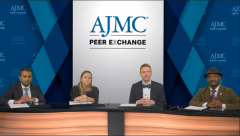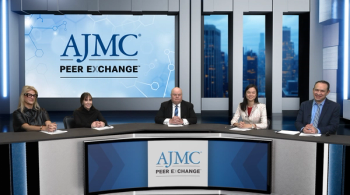
Providing Incentives for Provider Adherence to MM Pathway
Raymond Thertulien, MD, PhD, highlights provider incentives for adherence to MM treatment pathways.
Episodes in this series

Ryan Haumschild, PharmD, MS, MBA: You talked about adherence to pathways. That’s an important scenario. What are the incentives or disincentives offered for a provider’s adherence to pathways? In other words, what happens when you have a provider that’s 90% vs a provider that’s 50%? How do you deal with those different decisions as they come up?
Raymond Thertulien, MD, PhD: I don’t know. But we have a similar method of incorporating our clinical trials into the clinical pathways. Physicians outside the center can go into the EMR [electronic medical record], choose a regimen for myeloma, and see the options for clinical trials. They can contact us to see whether those trials are available for their patients to participate in. That system works well. All institutions are incorporating their clinical trials into the EMR, so the community physicians can see them.
In the practice of medicine, we all have to be cost-conscious. One purpose of establishing a clinical pathway is to bring a quality of care to patients by trying to standardize, as much as possible, the care we provide. But this also to serve as a cost containment. We use a lot of expensive medications in medicine in general and in myeloma in particular. In developing our clinical pathways, we’ve started doing cost-benefit analysis. We have a lot of regimens—they’re all triplets—and we do the cost-benefit analysis. We make all of them available on the pathway, but we tend to put the 1 that has the lowest cost with similar efficacy first. There are going to be some preferred regimens, even though they may all be efficacious in that line of therapy. We’ve started developing these types of analyses to make it transparent to the providers to help them choose the regimen they’re going to use in that line of therapy, based on not only efficacy and safety data but also the cost analysis.
Ryan Haumschild, PharmD, MS, MBA: Excellent. That’s important. Near and dear to my heart is pharmaco-economic evaluation. We have a high-cost disease state like multiple myeloma, but we also have to be stewards of the total cost of care and financial toxicity, and we can’t look at them in a silo. We have to evaluate that as part of this decision-making. It’s great to see that you’re incorporating that.
As someone who’s developed these internal pathways, I’m sure that’s something many providers struggle with. We have emerging data. We can start doing a combination of BCMA agents, bispecifics, and second-line therapy. But Dr Nadeem, how do we make sure we’re being stewards of health care costs for our patients and our health system? What clinical survival and safety data and nonclinical cost, patient assistance, and outcomes do you find to be high value in multiple myeloma? Of that evidence, which is most influential as you’re prioritizing therapies?
Omar Nadeem, MD: That’s a great question, and it’s complicated. I’ll talk first about the clinical factors. Things have improved so much in multiple myeloma in terms of prognosis that we don’t always get the traditional overall survival data that were the gold standard. It’s still a gold standard: to change practice for a disease that’s incurable. That said, we don’t always have that answer for a long time. The MAIA study just shared that with us all these years later. But we changed our practice a bit before that, so we look at surrogates for that. We look at MRD [minimal residual disease], we look at response rates and progression-free survival. Those are substitutes for what we consider to be the ultimate benefit. I consider those to be some of the most important clinical factors: thinking about incorporating a new treatment regimen, not just in pathways but in practice.
We have to think about safety. A lot of these therapies have different toxicities, so we’re looking at any toxicity of interest—belantamab and keratopathy, for example, or CRS [cytokine release syndrome] with some of our newer agents. As we incorporate some of these into our practice, we need to think about how that’s going to play out. You can put something in the pathways all you want, but if a center is unable to accommodate some of these therapies because of their toxicities or coordination with a certain practice, then it’s not so useful. We think about some of these things and the complexities of it when it comes to patient experience and the ability of a site to administer therapies that were recommended. These factors come into consideration when we’re building our pathways.
In terms of other nonclinical factors, cost has been brought up. That’s a huge topic, and it needs to be addressed because the way things are going in our field, particularly in multiple myeloma, we’re giving many drugs together, we’re doing expensive immunotherapies, a lot of times until progression. How is this going to be sustained? This is where I’m hoping trials come in that look at fixed-duration therapy and stratifying patients based on response, wherever they are in their disease. That’s going to be critical in the next wave of myeloma trials, which will hopefully allow some of that cost pressure to come down.
Right now we review the cost of an individual drug and we have a discussion about it. Is that the ultimate reason to incorporate, or not incorporate, something into our pathways? No. That’s not something we feel is our role in that space. It’s something we acknowledge, and we may prioritize certain regimens if there’s a cost benefit. But we don’t feel that we can’t incorporate something simply because of cost and the way things are structured in the health care system in the United States.
Some of these therapies are oral, and that has a huge implication in terms of out-of-pocket cost. We think about prescribing some of these therapies, infusional vs oral. How is that going to impact the patient? How are they going to tolerate it, and what will they have to pay for it? Those are real considerations in terms of having good patient-assistance programs. Now we’re talking about therapies that they may have to go to a different center for and stay for a month. These are things happening in myeloma. How is that going to be paid for? Thinking about patient-related cost factors, in terms of out-of-pocket cost, is critical when you design some of these pathways and make management decisions.
Ryan Haumschild, PharmD, MS, MBA: These are not easy decisions. Looking at the data alone, there are so many choices we can have for patients, and then we have to figure out the cost. One thing you said is that we’re seeing this emergence of treatments in multiple myeloma. It’s a great thing for patients to have multiple options. We don’t have to keep everything in the back pocket, even though we may keep a few. One thing is to look at, especially with cellular therapies, is CRS. How do we evaluate if a patient is fit? If they’re not thoroughly fit for cellular therapy and end up in the hospital multiple times due to CRS, there’s a high total cost of care. How do we consider those patient considerations? With bispecific or quadruplet therapies, this is an emerging area, and there’s going to be more pressure. I appreciate you acknowledging that and talking this through. It’s extremely helpful.
Transcript edited for clarity.
Newsletter
Stay ahead of policy, cost, and value—subscribe to AJMC for expert insights at the intersection of clinical care and health economics.





























































